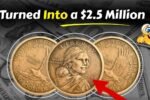Join on WhatsApp
Get the latest updates directly on WhatsApp – motivation, news & more!
In a quiet Arkansas town, an ordinary day at the bank turned into an extraordinary moment. A teller, while sorting through a bag of dollar coins, noticed something unusual. Among the golden Sacagawea Dollars was a coin that seemed out of place it bore the face of George Washington instead of Sacagawea. What the teller had stumbled upon was not just an odd-looking coin, but one of the rarest U.S. Mint mistakes in history: the 2000-P Sacagawea Dollar Mule Error.
After authentication by a leading grading service, the coin was valued at a staggering $70,000, immediately drawing the attention of collectors across the country.
What Makes the Mule Error Special?
In the world of numismatics, a “mule” is a coin created when dies intended for two different coins are mistakenly paired. In this case, the U.S. Mint accidentally struck a Washington Quarter obverse onto a Sacagawea Dollar blank, while keeping the reverse soaring eagle design.
The result: a coin that carries George Washington on the front and Sacagawea’s eagle on the back. With smooth dollar-style edges instead of the reeded edges of a quarter, the mule stands out to those who know what to look for. Only about 19 examples have ever been confirmed, making it a true rarity.
Why Collectors Are Excited
Stories like this ignite fresh enthusiasm in coin collecting. The idea that a coin worth tens of thousands of dollars could be hiding in everyday change fuels the imagination. Online coin forums and social media groups are buzzing with tips, photos, and hopeful searches through coin jars and bank rolls.
Experts point out that beyond its value, the mule error coin is a fascinating piece of minting history. “It’s the kind of mistake that simply shouldn’t happen, yet it did,” says one numismatist. “That’s what makes it so desirable.”
How to Spot One in Your Change
If you want to check your coins, here are the key signs:
- Obverse (front): George Washington’s portrait, like a quarter, with the date 2000 and “P” mintmark.
- Reverse (back): Sacagawea Dollar eagle design.
- Edge: Smooth, not reeded.
Anyone who suspects they may have one should avoid cleaning the coin and instead send it to a professional grading company such as PCGS or NGC.
Other Rare Sacagawea Varieties
The mule error isn’t the only valuable dollar coin. Collectors also prize the 2000-P “Cheerios” Dollar, given away in cereal boxes as a promotion, some of which feature a unique tail feather detail worth up to $25,000. Another variety, the Wounded Eagle Dollar, can fetch $5,000–$10,000 depending on condition.
A Modern-Day Treasure Hunt
The Arkansas discovery has reminded people that rare treasures still circulate in the most ordinary places. Whether tucked away in a piggy bank, handed back as change, or sitting unrecognized in a collection, the next mule error could be waiting to be found.
For coin enthusiasts, it’s more than just about money it’s about the thrill of holding history in your hand.


